The Musicarta Modes Workbook
The Mixolydian Mode (2)
Mixolydian ëVII–IV–I riffs
NOTE: Some computer
systems do not represent sharp and flat signs as entered by the author. ë indicates a flat sign and ì a sharp.
The most recognisable Mixolydian chord sequence is ëVII–IV–I (Flat Seven, Four, One).
Download up=to-date MIDI files for this page.
Riff One
Find the chords on the right hand side of this keyboards diagram.
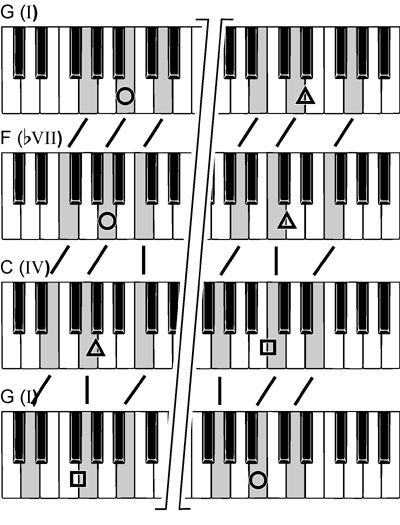
Play the four chords from the top down.
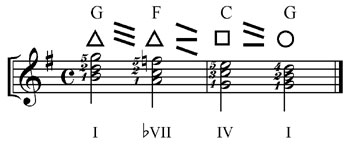
The chords are written an octave higher than they are played, to save you reading lots of ledger lines.
For our classic ëVII–IV–I riff, we need just the last three chords.
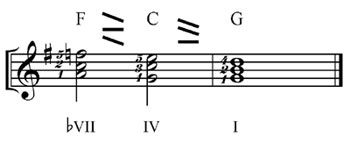
The falling top line (scale tones m7 – 6 – 5) is instantly recognisable. You can play either the roots in the bass, or a G pedal bass.
This combination of chords is the basis of lots of driving rock riffs.Here’s an example.
Riff Two
Here is a less powered-up riff which uses the same chords. In the audio clip you hear a pedal G bass, a root-of-the-chord bass, and a walking bass (which uses a Bë descending for effect).
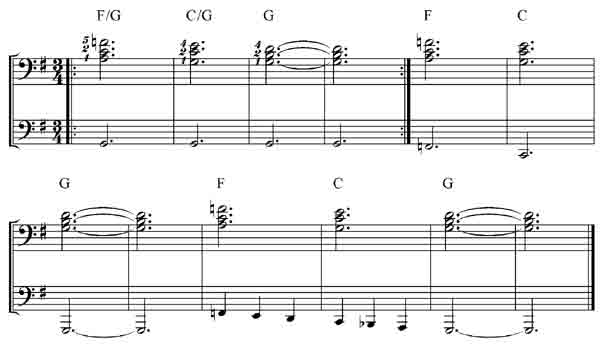
Riff Three
Here is a riff in rock three-four time using all four chords.

This music is very simplified.

Here is the chord sequence.
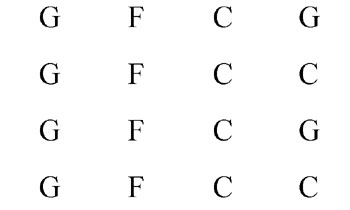
Riff Four
Now find the chords on the left hand side of the keyboards diagram.

Play them from the bottom up. Watch out for the bass clef in the written-out music.
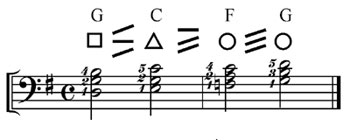
Here’s the riff based on these chords.
We have changed the inversions, we’re playing the chords in the reverse order, and the chords are rising rather than falling.
Note how, in all these manuscript examples, the key signature is the classical G major (to indicate that g is still the tonic/home chord. The F natural throughout indicates the Mixolydian mode.
Riff Five – a four-chord Mixolydian sequence
Here is a riff which uses the Mixolydian minor dominant (D minor in G Mixolydian).
Find the chords in this keyboards diagram.
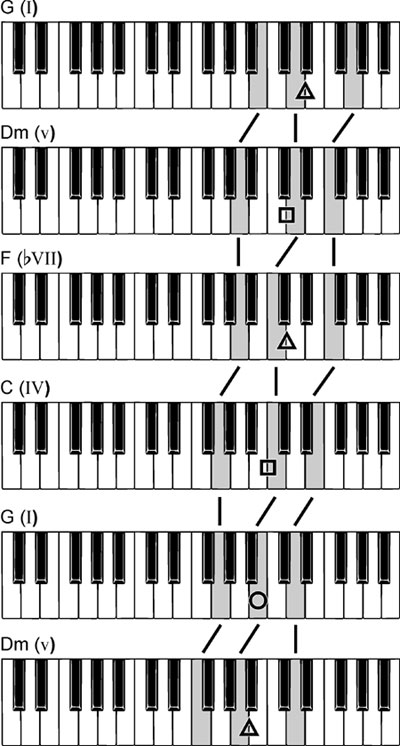
We use the top four chords first.
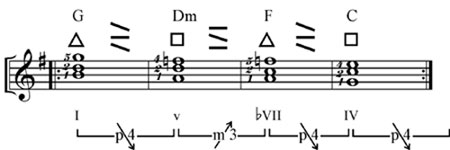
Play that in an easy groove like this.
Note: To avoid leger lines, the chords are written an octave higher than they are played.
Play it through twice. So far, our chord sequence looks like this:

Then use the bottom four chords from the keyboards diagram (from F down).
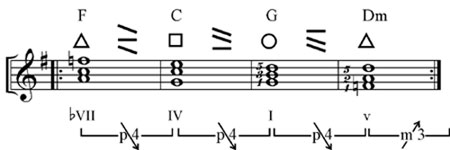

Play them twice and add them onto the first chord sequence.
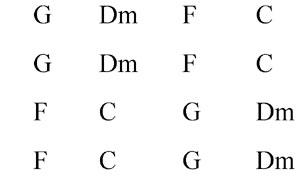
Double up phrases to make the whole thing longer. Use the first four chords for your song verse and the second four chords for the chorus.
Mixed major/Mixolydian sequences
Notice the restlessness of these Mixolydian chord sequences. You don’t quite know where ‘home’ is. To out modern ear, the modes (except for the Ionian) aren’t quite fully formed as a key system – which is precisely whty the Ionian ‘won out’ as the modern major, and the minor modes got a major dominant (V) chord and became the modern classical minor key.
The mixed riff
There’s no rule to say we can’t mix and match, though. In fact, the ëVII chord is often ‘borrowed in’ to regular Ionian-mode pop songs.
Listen to these four chords.

The only difference to the previous riff is that there is no F natural sign (ì) in the D chord, so the D chord stays major. Notice how the top note falls a semi-tone every chord change – something considered desirable in music generally.
Here’s a riff based on the four chords.

The left hand in this riff uses different inversions of the same chords.

Use them on their own as a simpler riff left hand if you wish.
Finally, here’s the third and final set of possible inversions, and a riff built on them.


Here’s a beat map for the complicated rhythm in the last audio clip.

Get a full description of the Musicarta beat maps and how to use them in Module Four of Musicarta’s Beat and Rhythm series: Exercises for Rhythm and Syncopation. The series also has graded exercise to help you build up to complicated rhythms like the attractive one used here.
|
OUT NOW! |
THE MUSICARTA BEAT & RHYTHM WORKBOOK At last! An effective approach to keyboard rhythm & syncopation skills. Learn more! |
ONLY $24.95! |
MODES |
The MusicartaA methodical approach to keyboard syncopation for
|
PUBLICATIONS
exciting keyboard
creativity courses
CHORDS 101
WORKBOOK

~HANON~
video course

Musicarta
Patreon
PENTATONICS
WORKBOOK
video course

Creative Keyboard
video course

BEAT AND RHYTHM
WORKBOOK

- Volume 1 -

12-BAR PIANO
STYLES WORKBOOK

MUSICARTA MODES
WORKBOOK

PIANO STYLE

CANON PROJECT
video course

VARIATIONS
video course


- Piano Solo -
video course

- Piano Solo -


YouTube playlists





 THE LOGO
THE LOGO
